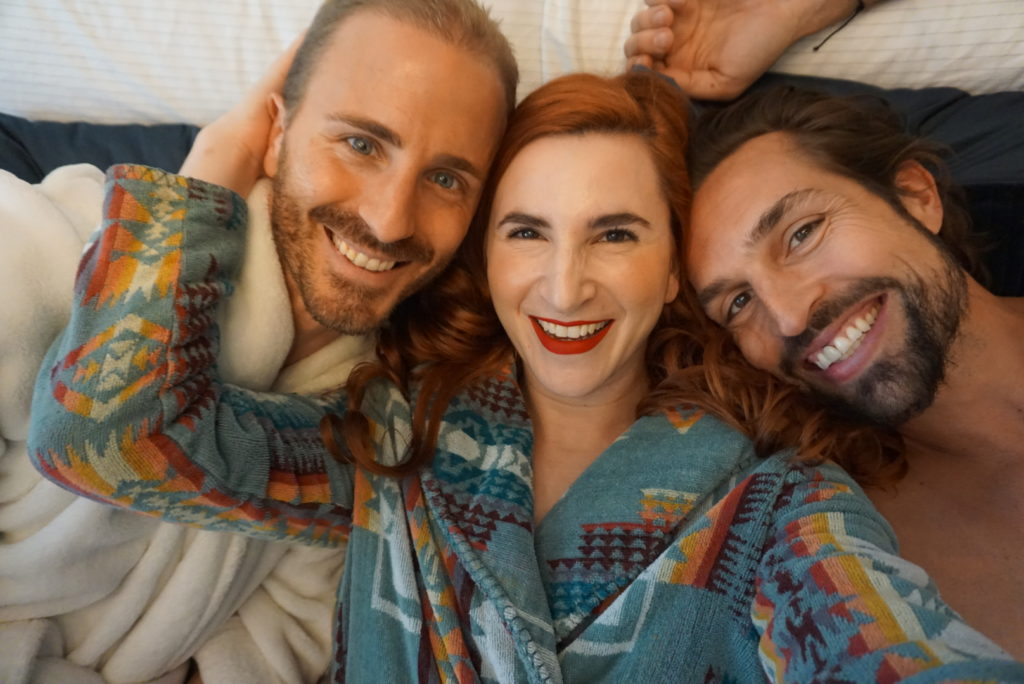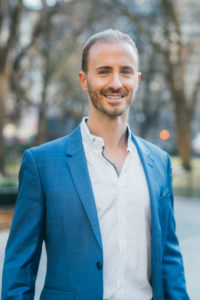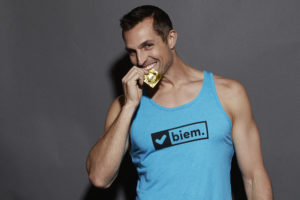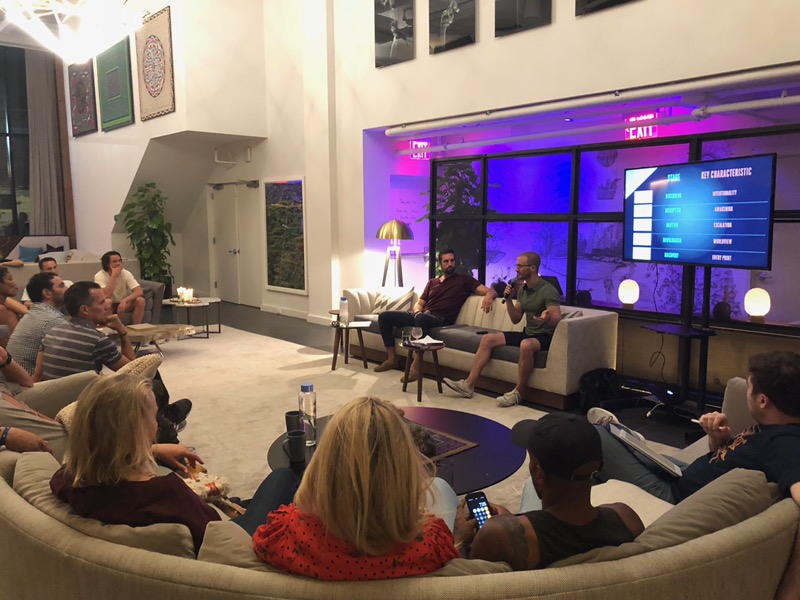
This is Dominick & Bryan. Seen through the lens of Inna Shnayder
To listen to this episode, click the sassy redhead on the peach background, and become a patron of the horizontal arts…
Lila: I have a patron who works as a nanny, and she says sex education begins very young, and it begins with body education, of your own body, of the, the child’s own body. It’s like, These are the parts of your body. This is what they’re called. It’s okay to touch yourself and feel good. It is better for you to do that, in your room. You know, This is not a thing to do at school. And then they’re not inoculated with that shame. They don’t have that embedded. And then, you know, they grow up a little bit more, and it’s like, Oh yeah, if you touch that, and it feels good, and then at some point it feels really good, this is what that is: that’s masturbating. And the thing at the end that happens sometimes, is an orgasm. It’s okay if an orgasm happens; it’s okay if it doesn’t happen. And then you start right then! Telling them, that pleasure is not orgasm-focused, that you can feel good by touching other parts of your body. There’s also a women named Sue Jaye Johnson, and she has a TED Talk, I think it’s a TEDx, and, it’s about teaching our kids about pleasure. So she, with her girls when they were young, would brush their hair and would say, “Does that feel good? Do you like that?” And so she, she modeled and taught, that there are all these different ways to experience p— I’m actually getting chills thinking about this — all up my legs, because, I so want people to know that there are all these different ways that they can experience pleasure, that they don’t have to source pleasure only from one: person. One: body part. One: activity. And, if we have this, really broad palette, of pleasure-inducing activities, I feel like, so many of our self-destructive habits would fall away— or would never become habits, because we would know that it was okay to do things that induce pleasure in us, and we would have a practice of doing that. From a very young age. And then, you know, so the kids maybe get a little bit older, and they start interacting with other people, and then you start talking about, Oh, well, yes, sometimes it feels good to touch somebody else. I like to hug my friends. Do you like to hug your friends? You know, How does it feel? Do you want to hug them like this? And then you start talking about, This is what sexy play is like. It’s better if you wait until you’re older to have this kind of play. It’s adult play. And this is what adults do together.
Bryan: I absolutely love the ramp up.
Lila: Yeah!
Bryan: Because I feel like so many parents are anxious about THE SEX TALK.
Lila: And it’s not one talk!
Bryan: It’s not! Yes, it’s not.
Lila: It’s a series of lessons and learnings throughout a young life… that would lead to a human who doesn’t have the kind of things to fight against that you did, you know?
Dominick: Yeah, instead, like the way it goes down is, it’s it’s not discussed, it’s, it’s pushed into the subterranean world, and then, in my high school, our Phys. Ed. teachers were the ones who taught us Sex Education. These gym teachers, unable to say the word “vagina,” because it was so — It was such a foreign concept to refer to a, a pussy for them, as a vagina, but then to even speak it out loud in front of students. And so those are the ambassadors, who are going to children — teenaged kids — and trying to teach that, when they’re uncomfortable. What you described is such a necessary way of us switching up the system, but the way it’s built now, the way it’s baked now, it’s just one shitstorm passed down over generations.
Lila: I honestly don’t know what the solution is, because I can’t actually imagine being able to get pleasure-inclusive, consent-based Sex Ed into all the high schools. And I think that’s what would do it. They need it— I mean, ideally they would have it earlier from a family, but, most of them will not, and we know that, so: high school.
Bryan: I believe you’re doing it. I believe this is where it starts. These types of conversations.

horizontal with Dominick & Bryan in Dom’s bed. New York, NY. April 2019
Dominick: We aren’t experts. We’re not doctors or therapists or trained physicians in any of this stuff. There’s a lot of great people who are already doing that work. I think where the challenges are, are creating these entry points for the mass, or the masses who don’t see this as something that needs to be discussed. Or think it’s weird to be discussed. Or think that going too far out on the sexual spectrum is intimidating for them. Bryan and I intend to be the bridge-builders, to the people like you, to the people like a sex therapist, or someone who’s a BDSM coach, like any of these areas that are too far out for the mainstream person right now? Bryan and I are like— we have their ear. And we want to make this more approachable for them.

This is Dominick.
Bryan: My dream was to start to change the culture— start to change why people get tested, start to change what people do with those test results afterwards. That was my dream. And what I realized, in the two years we’ve been running this, is that: it could be ready for that dream, but it’s not gonna help spur that. […] It’s only going to people that are currently getting tested— it’s not getting new people to go get tested right now, because the context with which that situation happens hasn’t changed; the conversation hasn’t changed. Yes, Biem is a great tool. Yes, everybody in the world should use it. But the context of like, “Hey, Lila, have you been tested?” That fear that invokes in most people, the chance at rejection that that invites, isn’t being changed. And that’s the conversation that Dominick and I are having with people, is how do we get comfortable in our own skin, to have the confidence and the self-worth, to realize that we can ask for what we want. We can go get tested and talk about these things. So I think the tools are great. But the answer is really in the conversation.
Lila: I look forward to these conversations that we’re having about ourselves— using ourselves as a vulnerable platform for this exploration and modeling these conversations… when they start to seep into media. So that, watching TV, watching Netflix, you can see somebody have a safer sex conversation before the sex scene.

This is Bryan. (Hungry?)
safer sex conversation (noun) = recognizing that sex is an inherently risky act, a safer sex conversation is a talk that ideally occurs before sexual activity takes place, and includes information such as: the last time everyone involved was tested for STI’s, current STI status, sexual engagement since the date of last testing, whether parties have been using birth control and what form of birth control, whether parties have been using measures for STI prevention with previous partners, which measures, and whether they would like to use those measures or other measures during this encounter, etc. It can also include sexual preferences like kinks, which may involve other risk factors that merit discussion.
O patrons, my patrons.
This is the month I get to celebrate the podcast breaking even! YESSSSSS! YESSSSSSSS! YEHEHESSSSSSS!
HAPPY DANCE for all of you!!!
Next month, on May 21st, I will further celebrate a horizontal-versary… two years of horizontality! I’ll be doing another Confetti Project photo shoot. I’m still percolating on other celebratory endeavors. Have you ideas? Do share!
This episode is the second part of my conversation with Dominick Q and Bryan Stacey, co-hosts of the Discerning Dick series and the Man Amongst Men podcast.

Bryan & Dominick at an evening of The Discerning Dick at The Assemblage
In episode 76. the discerning dick: horizontal with dudes who talk to dudes about sexuality, we talked about erections, the three F’s: forces which shaped their early view of sexuality: Faith, Family, & Friends. We talked about scrambled porn, masturbation, what the Bible actually says about premarital sex, Unitarian Universalism, bargaining with God over sexuality, and how Bryan’s sexual shame kept him from getting tested, and led to a dual diagnosis of testicular cancer and chlamydia.
You can find their projects together on the DoInnerWork.com website.
In this episode, we discuss drunk sex, how the sex talk is not One Talk, but a series of unfolding learnings about our bodies, desires, and interactions, changing the context in which we get tested for STD’s, pre-sex discernment & post-sex choice, going deeper rather than broader, my recent massive extended body orgasm, using body parts as derogatory terms, and the archetype of the King.

horizontal with Dominick & Bryan, in Dominick’s bed. New York, NY. April 2019
Next week’s episode of horizontal features two of my dearest friends, who also happen to be primary partners (with intricate and fascinating polycules of their own). The whole conversation is unprecedentedly robust and intimate. It is so robust and so powerful, that I am pretty sure it will necessitate more than two episodes! Still figuring out how that will play out.
Horizontal is becoming a viable project because of you: because of how you listen to it, love it, pledge to it, and share it with your beloveds. In the words of Maya Angelou’s favorite prayer:
Thank you Thank you Thank you.
Thank you for being the lifeblood of horizontal!
And now, come lie down with us again in New York, New York.
Links to things:
Dominick’s website, DominickQ.com & Dom on Instagram
Bryan’s Instagram, @talkingnut
Bryan’s Biem app, for getting tested for STI’s and sharing the results!
Dom & Bryan’s men’s work website: DoInnerWork.com
The Discerning Dick series
Sue Jaye Johnson’s TED Residency Talk, “What we don’t teach kids about sex”
How to have a safer sex conversation / Reid Mihalko’s Safer Sex Elevator Speech
Lila learned the concept of “post-sex choice” from the book Mate, by Geoffrey Miller & Tucker Max
What does it mean to “call in,” as opposed to “call out”?
King Warrior Magician Lover by Robert Moore, a book that Dom recommends every man read
Eve Ensler’s “Embrace your inner girl” talk
Eve Ensler: Embrace your inner girl
In this passionate talk, Eve Ensler declares that there is a girl cell in us all — a cell that we have all been taught to suppress. She tells heartfelt stories of girls around the world who have overcome shocking adversity and violence to reveal the astonishing strength of being a girl.

